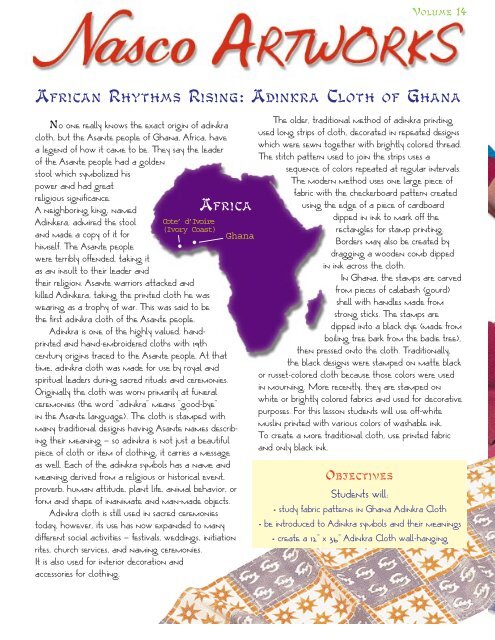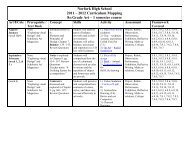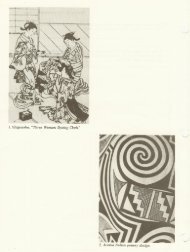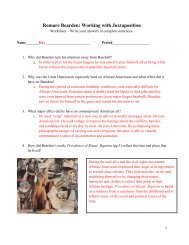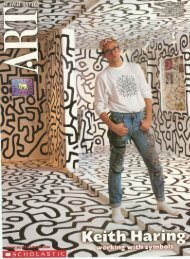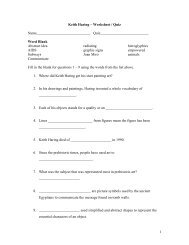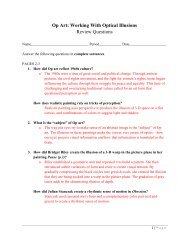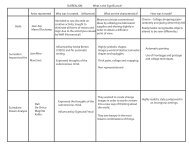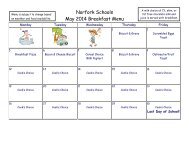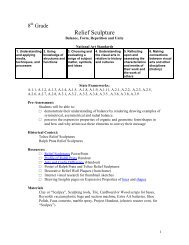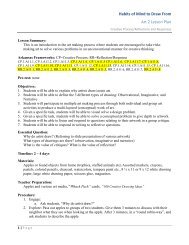Adinkra Cloth of Ghana
Adinkra Cloth of Ghana
Adinkra Cloth of Ghana
- No tags were found...
Create successful ePaper yourself
Turn your PDF publications into a flip-book with our unique Google optimized e-Paper software.
Volume 14African Rhythms Rising: <strong>Adinkra</strong> <strong>Cloth</strong> <strong>of</strong> <strong>Ghana</strong>No one really knows the exact origin <strong>of</strong> adinkracloth, but the Asante people <strong>of</strong> <strong>Ghana</strong>, Africa, havea legend <strong>of</strong> how it came to be. They say the leader<strong>of</strong> the Asante people had a goldenstool which symbolized hispower and had greatreligious significance.A neighboring king, namedAdinkera, admired the stooland made a copy <strong>of</strong> it forhimself. The Asante peoplewere terribly <strong>of</strong>fended, taking itas an insult to their leader andAfricaCote’ d’Ivoire(Ivory Coast)their religion. Asante warriors attacked andkilled Adinkera, taking the printed cloth he waswearing as a trophy <strong>of</strong> war. This was said to bethe first adinkra cloth <strong>of</strong> the Asante people.<strong>Adinkra</strong> is one <strong>of</strong> the highly valued, handprintedand hand-embroidered cloths with 19thcentury origins traced to the Asante people. At thattime, adinkra cloth was made for use by royal andspiritual leaders during sacred rituals and ceremonies.Originally the cloth was worn primarily at funeralceremonies (the word “adinkra” means “good-bye”in the Asante language). The cloth is stamped withmany traditional designs having Asante names describingtheir meaning — so adinkra is not just a beautifulpiece <strong>of</strong> cloth or item <strong>of</strong> clothing, it carries a messageas well. Each <strong>of</strong> the adinkra symbols has a name andmeaning derived from a religious or historical event,proverb, human attitude, plant life, animal behavior, orform and shape <strong>of</strong> inanimate and man-made objects.<strong>Adinkra</strong> cloth is still used in sacred ceremoniestoday, however, its use has now expanded to manydifferent social activities — festivals, weddings, initiationrites, church services, and naming ceremonies.It is also used for interior decoration andaccessories for clothing.●●<strong>Ghana</strong>The older, traditional method <strong>of</strong> adinkra printingused long strips <strong>of</strong> cloth, decorated in repeated designswhich were sewn together with brightly colored thread.The stitch pattern used to join the strips uses asequence <strong>of</strong> colors repeated at regular intervals.The modern method uses one large piece <strong>of</strong>fabric with the checkerboard pattern createdusing the edge <strong>of</strong> a piece <strong>of</strong> cardboarddipped in ink to mark <strong>of</strong>f therectangles for stamp printing.Borders may also be created bydragging a wooden comb dippedin ink across the cloth.In <strong>Ghana</strong>, the stamps are carvedfrom pieces <strong>of</strong> calabash (gourd)shell with handles made fromstrong sticks. The stamps aredipped into a black dye (made fromboiling tree bark from the badie tree),then pressed onto the cloth. Traditionally,the black designs were stamped on matte blackor russet-colored cloth because those colors were usedin mourning. More recently, they are stamped onwhite or brightly colored fabrics and used for decorativepurposes. For this lesson students will use <strong>of</strong>f-whitemuslin printed with various colors <strong>of</strong> washable ink.To create a more traditional cloth, use printed fabricand only black ink.ObjectivesStudents will:• study fabric patterns in <strong>Ghana</strong> <strong>Adinkra</strong> <strong>Cloth</strong>• be introduced to <strong>Adinkra</strong> symbols and their meanings• create a 12" x 36" <strong>Adinkra</strong> <strong>Cloth</strong> wall-hanging
Materials:• 4" x 6" NASCO Safety-Kutprinting block (one per student)(Cat. No. 9704655)• 12" x 36" muslin (one per student)• washable printing ink• washable markers• dowel rod, 12" x 1 ⁄4" diameter(one per student)• white string• lino cutters• brayers• inking trays• 4” x6” pieces <strong>of</strong> drawing paper(several pieces per student)• drawing pencilsDay 1 Introduction:Students should spend one day researching a variety<strong>of</strong> printed fabrics from Africa. This will give them backgroundinformation about the area and the meaningbehind each <strong>of</strong> the symbols.Day 2:Discuss the meanings <strong>of</strong> the different adinkra symbolswith the class and how they apply to their own lives.(See back <strong>of</strong> this flyer for a list <strong>of</strong> symbols and theirmeanings.) Give students several 4" x 6" pieces <strong>of</strong>paper and drawing pencils. Have students select anddraw two adinkra symbols repeatedly on separatesheets <strong>of</strong> paper.Day 3:Give each student one piece <strong>of</strong> NASCO Safety-Kutand show them how to lay their design face downon the block and rub the back with a ruler to transferthe design. Using the two designs they have selected,have them transfer one design onto each side <strong>of</strong>the Safety-Kut block. Give students a quickdemonstration on the safe use <strong>of</strong> lino-tools andlet them use the rest <strong>of</strong> the class period tocarve their designs.
Day 4:Have students print their designs on scrap paper usingwater-soluble markers to check for any areas that mayneed to be carved deeper. (It is better to check theprint now than to ruin a print later.)Day 5:Students select washable printing ink colors for theirproject. A brayer is used until the ink makes a “crackle”noise or you see a fish scale design on the ink tray.Tape the muslin to the table across the top <strong>of</strong> themuslin, this will create a nice one-inch white borderwhen finished. Students then print a checkerboardpattern (meaning every other one). There will besix rows. Allow to dry over night.Day 6:Students use their second design to fill in the checkerboarddesign. Once again, allow to dry over night.Day 7:Each student is given a 12-inch dowel rod. Dowel rodsmay be notched with a saw. Using approximately 36inches <strong>of</strong> string, lay the string across the dowel rodand through the notches. Use glue or tape next tothe notches so that the string doesn’t pull out. Fold thetop <strong>of</strong> the muslin over the dowel rod until fabric touchesfabric. Then use a stapler that has been opened tostaple the fabric onto it. This sometimes takes a fewpractices. (Fabric or craft glue will also work.)
<strong>Adinkra</strong> SymbolsGye nyame — symbol <strong>of</strong> the omnipotence and immortality <strong>of</strong> God.“Funtun funafu denkyem funafu won afuru bom nso worididi a na wo ko.”“Sharing one stomach yet they fight over food.”Nsoroma — a child <strong>of</strong> the heavens. Symbol <strong>of</strong> dependence on God.Nkonsonkonso — link or chain. Symbol <strong>of</strong> human relations.Osram ne nsoroma — the moon and star. Symbol <strong>of</strong> loyalty, faithfulness, harmony, and love.Nyame dua — an altar or place <strong>of</strong> worship.Nyame nwu na mawu — “God does not die, and so I don’t die”. Symbol <strong>of</strong> the all-knowingness and everpresence<strong>of</strong> God.Akoma — the heart. Symbol <strong>of</strong> love, patience, goodwill, and endurance.Finhankra — symbol <strong>of</strong> safety and security in a home.Nkyin kyin — changing one’s self. Playing many roles.Dwanimen (Ram’s horn). “Dwonnin ye asis a ode n’akorana na ennye ne mben. It is the heart and not thehorns that leads a ram to bully. Concealment.Aya (the firn). This word also means “I am not afraid <strong>of</strong> you.” A symbol <strong>of</strong> defiance.Hye wo nyhe — “the one who burns you be not burned”. Symbol <strong>of</strong> forgiveness. Turn the other cheek.Other NASCO ArtWorks Lesson Plans are available on our Web siteat www.eNASCO.com• 901 Janesville Ave., Fort Atkinson, WI 53538-0901 • E-mail: info@eNASCO.com• 4825 Stoddard Rd., Modesto, CA 95356-1669 • E-mail: modesto@eNASCO.comWorld Wide Web site: www.eNASCO.com1-800-558-9595NP 03-00PRINTED IN THE U.S.A.MARCH 2000


